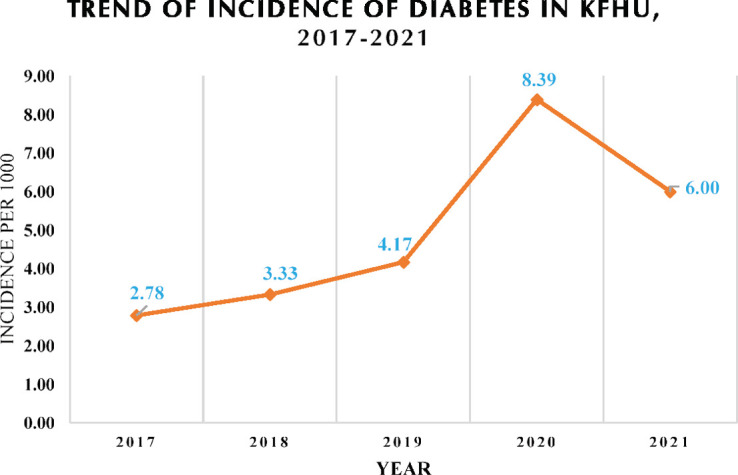The Impact of COVID-19 Lockdown on the Incidence of Type 1 DM and the Glycemic Control of Diabetic Children: Findings from a Teaching Hospital, Saudi Arabia.
Q3 Medicine
引用次数: 2
Abstract
OBJECTIVE We evaluated glycemic control among T1DM pediatric patients attending the endocrinology pediatrics clinics at King Fahd Hospital of the University (KFHU) prior to and during COVID-19 restraining regulations. In addition, we assessed the trends and variations in the incidence of T1DM during 2017-2021, including the COVID-19 years by identifying newly diagnosed patients presenting to pediatrics emergency department (ED) in KFHU. METHODS To estimate the effect of COVID-19 on the incidence of T1DM, we identified newly diagnosed cases of T1DM among pediatric patients attending the ED during the years 20172021. The participants’ data were collected through electronic medical records. Information collected included patient age, sex, and HbA1c readings. Three HbA1c readings of interest that were defined and collected are pre-COVID reading, in-COVID reading, and post-COVID reading. RESULTS The difference of female participants’ readings was statistically non-significant (Z= -0.416, p = 0.678), with a pre- and post-COVID median of 10.70 (Q1= 9.00, Q3= 12.15), and 10.50 (Q1= 8.80, Q3= 12.35), respectively. In contrast, the difference was statistically significant among male participants (Z= -2.334, p = 0.02), with a pre- and post-COVID median of 10.20 (Q1= 8.70, Q3= 11.80), and 10.65 (Q1= 9.00, Q3= 12.70), respectively. There was a statistically significant increase in HbA1c of persons > 11 years old (Z= -2.471, p= 0.013), with a pre- and post-COVID median of 10.40 (Q1= 9.00, Q3= 12.10), and 10.90 (Q1= 9.00, Q3= 12.60), respectively. Conversely, persons ≤ 11 years old showed no statistically significant change in HbA1c (Z= -.457, p= 0.648), with a pre- and post-COVID median of 10.45 (Q1= 8.70, Q3= 11.85), and 10.20 (Q1= 8.40, Q3= 12.075), respectively. Disregarding any influence of time, the effect of sex showed no statistically significant difference in HbA1c between males and females [F (1,125) = 0.008, p = 0.930]. Meanwhile, the age effect on HbA1c, regardless of time influence, was statistically significant [F (1,125) = 4.993, p = 0.027]. There was no statistically significant interaction between time and sex on HbA1c levels [F (1.74, 217) = 0.096, p = 0.883] and between age and time [F (3.92,289.57) = 1.693, p = 0.190]. CONCLUSIONS The number of visits to healthcare facilities dropped significantly during the COVID-19 pandemic, but the rate of newly diagnosed T1DM increased. There was a variable effect on HbA1c levels of those patients, which suggests that each demographic group in the population might have been affected differently by the pandemic. Future research should determine factors associated with better glycemic control and measures to sustain these changes the pandemic might have created.


COVID-19封锁对糖尿病儿童1型糖尿病发病率和血糖控制的影响:来自沙特阿拉伯一家教学医院的研究结果
目的:我们评估在COVID-19抑制法规出台之前和期间在法赫德国王大学医院(KFHU)内分泌儿科诊所就诊的T1DM儿科患者的血糖控制情况。此外,我们通过确定在KFHU儿科急诊科(ED)就诊的新诊断患者,评估了2017-2021年(包括COVID-19年)T1DM发病率的趋势和变化。方法:为了估计COVID-19对T1DM发病率的影响,我们确定了2017- 2021年在急诊科就诊的儿科患者中新诊断的T1DM病例。参与者的数据是通过电子病历收集的。收集的信息包括患者的年龄、性别和HbA1c读数。定义和收集的三个感兴趣的HbA1c读数是covid前读数、covid中读数和covid后读数。结果:女性受试者的读数差异无统计学意义(Z= -0.416, p = 0.678),中位数分别为10.70 (Q1= 9.00, Q3= 12.15)和10.50 (Q1= 8.80, Q3= 12.35)。相比之下,男性参与者的中位数差异具有统计学意义(Z= -2.334, p = 0.02),其中冠状病毒感染前和冠状病毒感染后的中位数分别为10.20 (Q1= 8.70, Q3= 11.80)和10.65 (Q1= 9.00, Q3= 12.70)。> 11岁人群HbA1c升高有统计学意义(Z= -2.471, p= 0.013),感染前和感染后中位数分别为10.40 (Q1= 9.00, Q3= 12.10)和10.90 (Q1= 9.00, Q3= 12.60)。相反,≤11岁者HbA1c无统计学意义变化(Z= -)。457, p= 0.648),中位数分别为10.45 (Q1= 8.70, Q3= 11.85)和10.20 (Q1= 8.40, Q3= 12.075)。在不考虑时间影响的情况下,性别对男女HbA1c的影响无统计学意义[F (1,125) = 0.008, p = 0.930]。同时,年龄对HbA1c的影响不受时间影响,均有统计学意义[F (1,125) = 4.993, p = 0.027]。时间与性别对HbA1c水平的影响无统计学意义[F (1.74, 217) = 0.096, p = 0.883],年龄与时间的影响[F (3.92,289.57) = 1.693, p = 0.190]。结论:在2019冠状病毒病大流行期间,到医疗机构就诊的人数显著下降,但新诊断T1DM的比例上升。这些患者的HbA1c水平有不同的影响,这表明人口中的每个人口群体可能受到大流行的不同影响。未来的研究应确定与更好的血糖控制有关的因素,并采取措施维持大流行可能造成的这些变化。
本文章由计算机程序翻译,如有差异,请以英文原文为准。
求助全文
约1分钟内获得全文
求助全文
来源期刊

Review of Diabetic Studies
Medicine-Internal Medicine
CiteScore
1.80
自引率
0.00%
发文量
28
期刊介绍:
The Review of Diabetic Studies (RDS) is the society"s peer-reviewed journal published quarterly. The purpose of The RDS is to support and encourage research in biomedical diabetes-related science including areas such as endocrinology, immunology, epidemiology, genetics, cell-based research, developmental research, bioengineering and disease management.
 求助内容:
求助内容: 应助结果提醒方式:
应助结果提醒方式:


